Mr. Ferguson - Nursing Assignment
VerifiedAdded on 2021/06/14
|8
|2320
|59
AI Summary
Contribute Materials
Your contribution can guide someone’s learning journey. Share your
documents today.
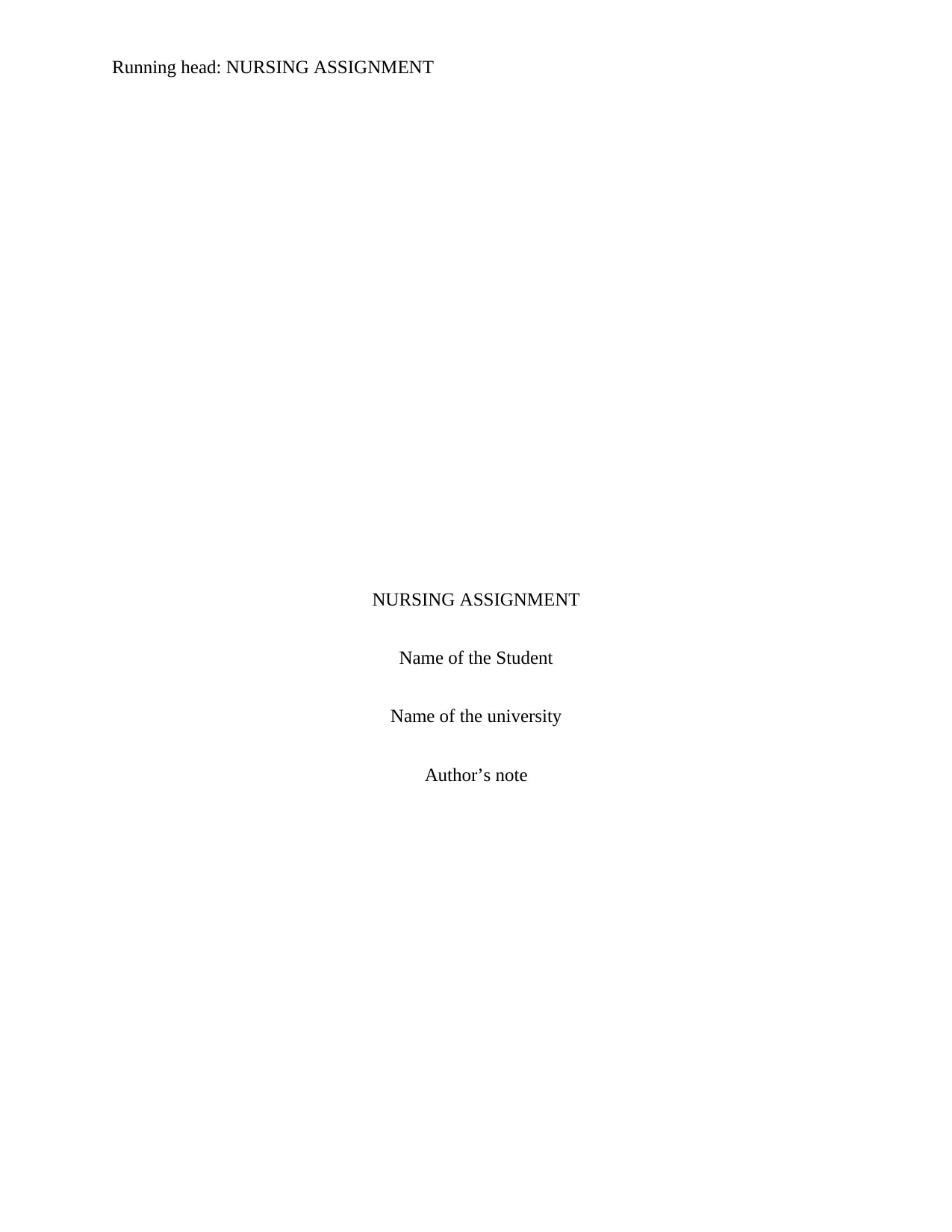
Running head: NURSING ASSIGNMENT
NURSING ASSIGNMENT
Name of the Student
Name of the university
Author’s note
NURSING ASSIGNMENT
Name of the Student
Name of the university
Author’s note
Secure Best Marks with AI Grader
Need help grading? Try our AI Grader for instant feedback on your assignments.
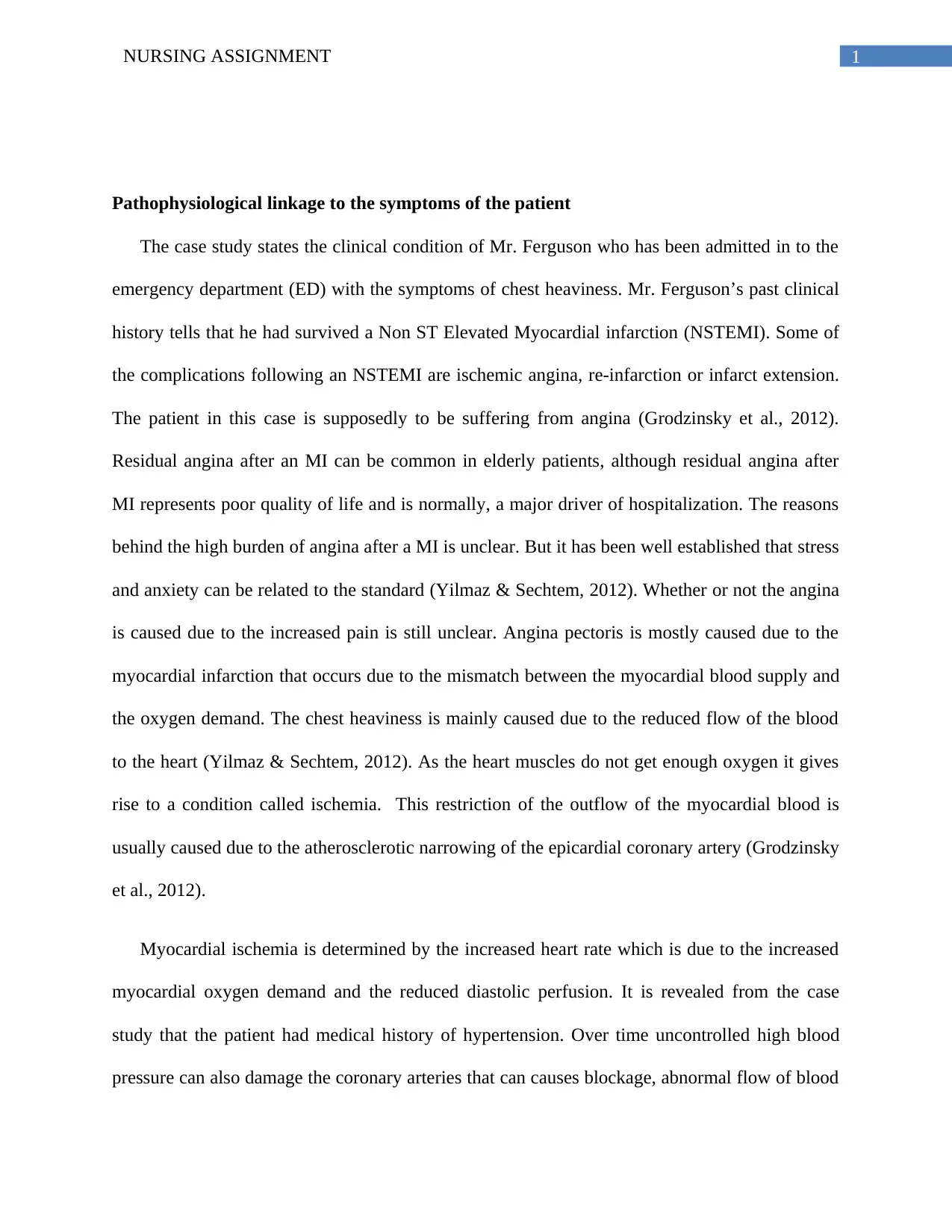
1NURSING ASSIGNMENT
Pathophysiological linkage to the symptoms of the patient
The case study states the clinical condition of Mr. Ferguson who has been admitted in to the
emergency department (ED) with the symptoms of chest heaviness. Mr. Ferguson’s past clinical
history tells that he had survived a Non ST Elevated Myocardial infarction (NSTEMI). Some of
the complications following an NSTEMI are ischemic angina, re-infarction or infarct extension.
The patient in this case is supposedly to be suffering from angina (Grodzinsky et al., 2012).
Residual angina after an MI can be common in elderly patients, although residual angina after
MI represents poor quality of life and is normally, a major driver of hospitalization. The reasons
behind the high burden of angina after a MI is unclear. But it has been well established that stress
and anxiety can be related to the standard (Yilmaz & Sechtem, 2012). Whether or not the angina
is caused due to the increased pain is still unclear. Angina pectoris is mostly caused due to the
myocardial infarction that occurs due to the mismatch between the myocardial blood supply and
the oxygen demand. The chest heaviness is mainly caused due to the reduced flow of the blood
to the heart (Yilmaz & Sechtem, 2012). As the heart muscles do not get enough oxygen it gives
rise to a condition called ischemia. This restriction of the outflow of the myocardial blood is
usually caused due to the atherosclerotic narrowing of the epicardial coronary artery (Grodzinsky
et al., 2012).
Myocardial ischemia is determined by the increased heart rate which is due to the increased
myocardial oxygen demand and the reduced diastolic perfusion. It is revealed from the case
study that the patient had medical history of hypertension. Over time uncontrolled high blood
pressure can also damage the coronary arteries that can causes blockage, abnormal flow of blood
Pathophysiological linkage to the symptoms of the patient
The case study states the clinical condition of Mr. Ferguson who has been admitted in to the
emergency department (ED) with the symptoms of chest heaviness. Mr. Ferguson’s past clinical
history tells that he had survived a Non ST Elevated Myocardial infarction (NSTEMI). Some of
the complications following an NSTEMI are ischemic angina, re-infarction or infarct extension.
The patient in this case is supposedly to be suffering from angina (Grodzinsky et al., 2012).
Residual angina after an MI can be common in elderly patients, although residual angina after
MI represents poor quality of life and is normally, a major driver of hospitalization. The reasons
behind the high burden of angina after a MI is unclear. But it has been well established that stress
and anxiety can be related to the standard (Yilmaz & Sechtem, 2012). Whether or not the angina
is caused due to the increased pain is still unclear. Angina pectoris is mostly caused due to the
myocardial infarction that occurs due to the mismatch between the myocardial blood supply and
the oxygen demand. The chest heaviness is mainly caused due to the reduced flow of the blood
to the heart (Yilmaz & Sechtem, 2012). As the heart muscles do not get enough oxygen it gives
rise to a condition called ischemia. This restriction of the outflow of the myocardial blood is
usually caused due to the atherosclerotic narrowing of the epicardial coronary artery (Grodzinsky
et al., 2012).
Myocardial ischemia is determined by the increased heart rate which is due to the increased
myocardial oxygen demand and the reduced diastolic perfusion. It is revealed from the case
study that the patient had medical history of hypertension. Over time uncontrolled high blood
pressure can also damage the coronary arteries that can causes blockage, abnormal flow of blood
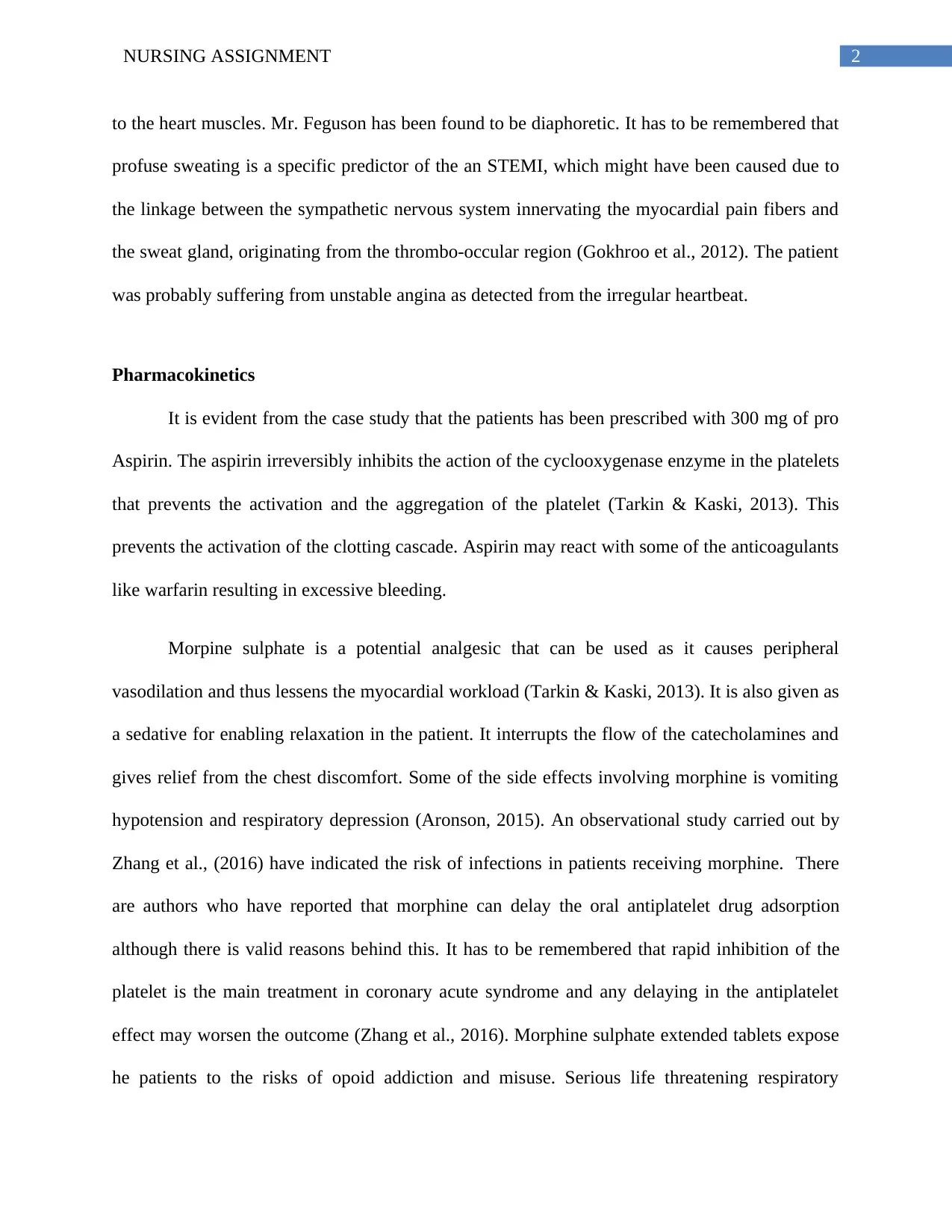
2NURSING ASSIGNMENT
to the heart muscles. Mr. Feguson has been found to be diaphoretic. It has to be remembered that
profuse sweating is a specific predictor of the an STEMI, which might have been caused due to
the linkage between the sympathetic nervous system innervating the myocardial pain fibers and
the sweat gland, originating from the thrombo-occular region (Gokhroo et al., 2012). The patient
was probably suffering from unstable angina as detected from the irregular heartbeat.
Pharmacokinetics
It is evident from the case study that the patients has been prescribed with 300 mg of pro
Aspirin. The aspirin irreversibly inhibits the action of the cyclooxygenase enzyme in the platelets
that prevents the activation and the aggregation of the platelet (Tarkin & Kaski, 2013). This
prevents the activation of the clotting cascade. Aspirin may react with some of the anticoagulants
like warfarin resulting in excessive bleeding.
Morpine sulphate is a potential analgesic that can be used as it causes peripheral
vasodilation and thus lessens the myocardial workload (Tarkin & Kaski, 2013). It is also given as
a sedative for enabling relaxation in the patient. It interrupts the flow of the catecholamines and
gives relief from the chest discomfort. Some of the side effects involving morphine is vomiting
hypotension and respiratory depression (Aronson, 2015). An observational study carried out by
Zhang et al., (2016) have indicated the risk of infections in patients receiving morphine. There
are authors who have reported that morphine can delay the oral antiplatelet drug adsorption
although there is valid reasons behind this. It has to be remembered that rapid inhibition of the
platelet is the main treatment in coronary acute syndrome and any delaying in the antiplatelet
effect may worsen the outcome (Zhang et al., 2016). Morphine sulphate extended tablets expose
he patients to the risks of opoid addiction and misuse. Serious life threatening respiratory
to the heart muscles. Mr. Feguson has been found to be diaphoretic. It has to be remembered that
profuse sweating is a specific predictor of the an STEMI, which might have been caused due to
the linkage between the sympathetic nervous system innervating the myocardial pain fibers and
the sweat gland, originating from the thrombo-occular region (Gokhroo et al., 2012). The patient
was probably suffering from unstable angina as detected from the irregular heartbeat.
Pharmacokinetics
It is evident from the case study that the patients has been prescribed with 300 mg of pro
Aspirin. The aspirin irreversibly inhibits the action of the cyclooxygenase enzyme in the platelets
that prevents the activation and the aggregation of the platelet (Tarkin & Kaski, 2013). This
prevents the activation of the clotting cascade. Aspirin may react with some of the anticoagulants
like warfarin resulting in excessive bleeding.
Morpine sulphate is a potential analgesic that can be used as it causes peripheral
vasodilation and thus lessens the myocardial workload (Tarkin & Kaski, 2013). It is also given as
a sedative for enabling relaxation in the patient. It interrupts the flow of the catecholamines and
gives relief from the chest discomfort. Some of the side effects involving morphine is vomiting
hypotension and respiratory depression (Aronson, 2015). An observational study carried out by
Zhang et al., (2016) have indicated the risk of infections in patients receiving morphine. There
are authors who have reported that morphine can delay the oral antiplatelet drug adsorption
although there is valid reasons behind this. It has to be remembered that rapid inhibition of the
platelet is the main treatment in coronary acute syndrome and any delaying in the antiplatelet
effect may worsen the outcome (Zhang et al., 2016). Morphine sulphate extended tablets expose
he patients to the risks of opoid addiction and misuse. Serious life threatening respiratory
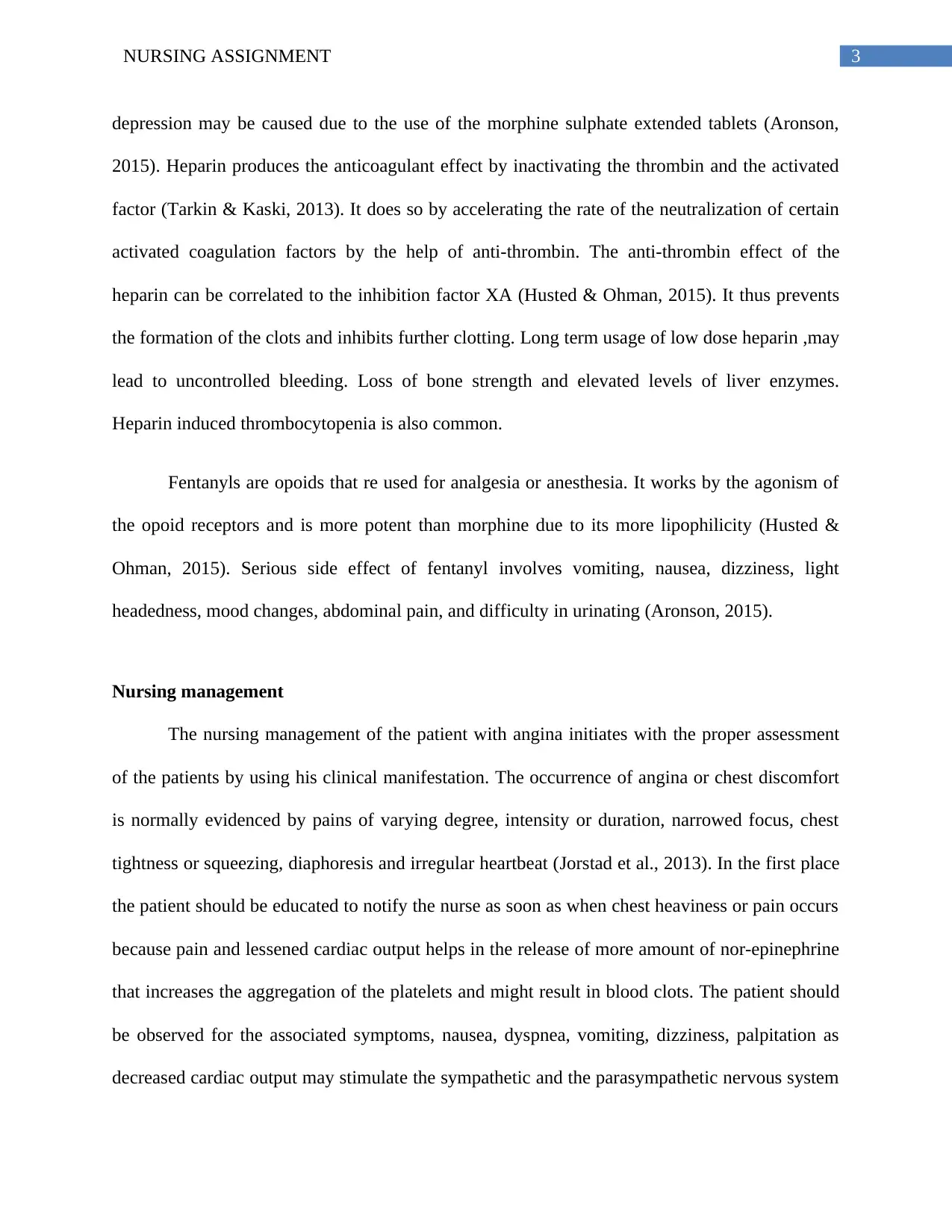
3NURSING ASSIGNMENT
depression may be caused due to the use of the morphine sulphate extended tablets (Aronson,
2015). Heparin produces the anticoagulant effect by inactivating the thrombin and the activated
factor (Tarkin & Kaski, 2013). It does so by accelerating the rate of the neutralization of certain
activated coagulation factors by the help of anti-thrombin. The anti-thrombin effect of the
heparin can be correlated to the inhibition factor XA (Husted & Ohman, 2015). It thus prevents
the formation of the clots and inhibits further clotting. Long term usage of low dose heparin ,may
lead to uncontrolled bleeding. Loss of bone strength and elevated levels of liver enzymes.
Heparin induced thrombocytopenia is also common.
Fentanyls are opoids that re used for analgesia or anesthesia. It works by the agonism of
the opoid receptors and is more potent than morphine due to its more lipophilicity (Husted &
Ohman, 2015). Serious side effect of fentanyl involves vomiting, nausea, dizziness, light
headedness, mood changes, abdominal pain, and difficulty in urinating (Aronson, 2015).
Nursing management
The nursing management of the patient with angina initiates with the proper assessment
of the patients by using his clinical manifestation. The occurrence of angina or chest discomfort
is normally evidenced by pains of varying degree, intensity or duration, narrowed focus, chest
tightness or squeezing, diaphoresis and irregular heartbeat (Jorstad et al., 2013). In the first place
the patient should be educated to notify the nurse as soon as when chest heaviness or pain occurs
because pain and lessened cardiac output helps in the release of more amount of nor-epinephrine
that increases the aggregation of the platelets and might result in blood clots. The patient should
be observed for the associated symptoms, nausea, dyspnea, vomiting, dizziness, palpitation as
decreased cardiac output may stimulate the sympathetic and the parasympathetic nervous system
depression may be caused due to the use of the morphine sulphate extended tablets (Aronson,
2015). Heparin produces the anticoagulant effect by inactivating the thrombin and the activated
factor (Tarkin & Kaski, 2013). It does so by accelerating the rate of the neutralization of certain
activated coagulation factors by the help of anti-thrombin. The anti-thrombin effect of the
heparin can be correlated to the inhibition factor XA (Husted & Ohman, 2015). It thus prevents
the formation of the clots and inhibits further clotting. Long term usage of low dose heparin ,may
lead to uncontrolled bleeding. Loss of bone strength and elevated levels of liver enzymes.
Heparin induced thrombocytopenia is also common.
Fentanyls are opoids that re used for analgesia or anesthesia. It works by the agonism of
the opoid receptors and is more potent than morphine due to its more lipophilicity (Husted &
Ohman, 2015). Serious side effect of fentanyl involves vomiting, nausea, dizziness, light
headedness, mood changes, abdominal pain, and difficulty in urinating (Aronson, 2015).
Nursing management
The nursing management of the patient with angina initiates with the proper assessment
of the patients by using his clinical manifestation. The occurrence of angina or chest discomfort
is normally evidenced by pains of varying degree, intensity or duration, narrowed focus, chest
tightness or squeezing, diaphoresis and irregular heartbeat (Jorstad et al., 2013). In the first place
the patient should be educated to notify the nurse as soon as when chest heaviness or pain occurs
because pain and lessened cardiac output helps in the release of more amount of nor-epinephrine
that increases the aggregation of the platelets and might result in blood clots. The patient should
be observed for the associated symptoms, nausea, dyspnea, vomiting, dizziness, palpitation as
decreased cardiac output may stimulate the sympathetic and the parasympathetic nervous system
Secure Best Marks with AI Grader
Need help grading? Try our AI Grader for instant feedback on your assignments.
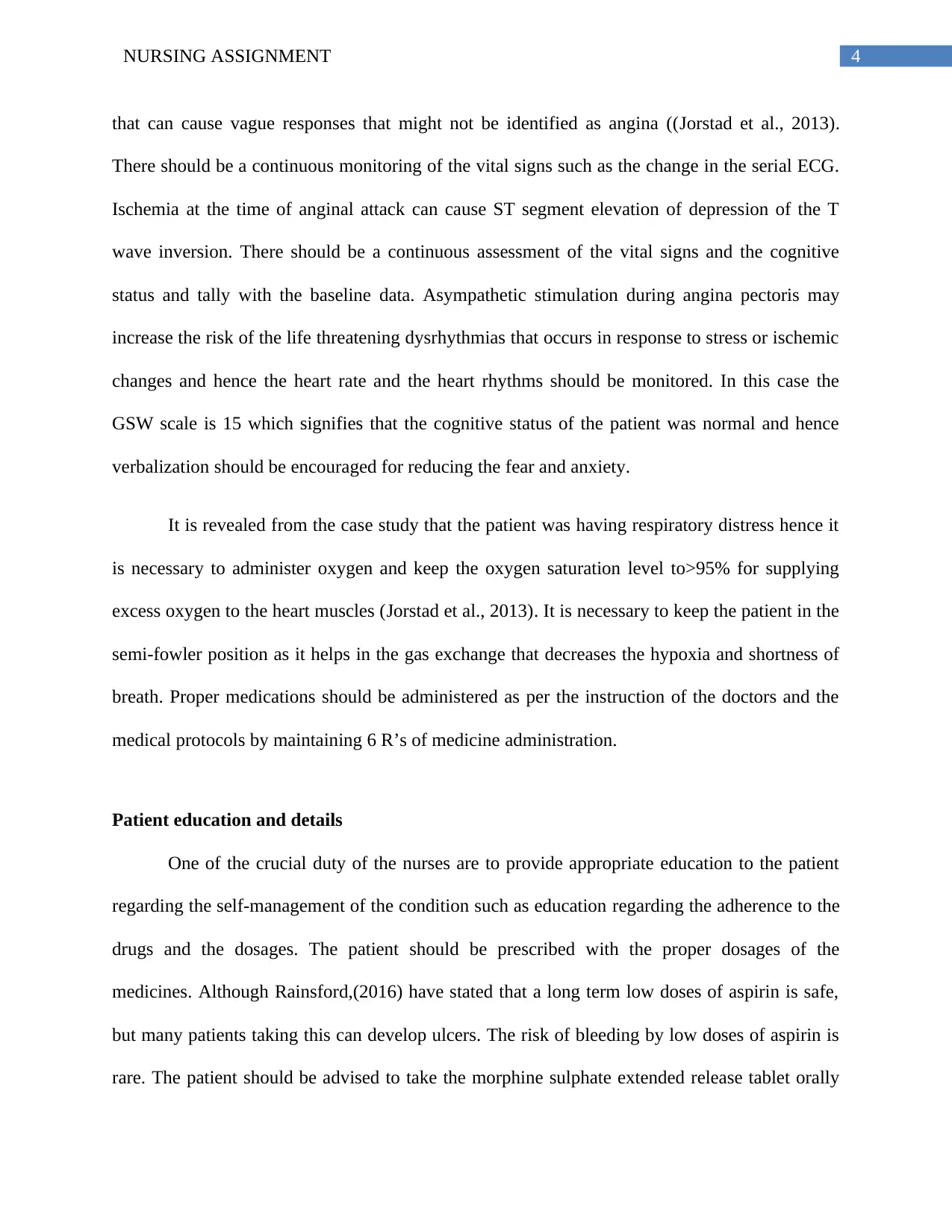
4NURSING ASSIGNMENT
that can cause vague responses that might not be identified as angina ((Jorstad et al., 2013).
There should be a continuous monitoring of the vital signs such as the change in the serial ECG.
Ischemia at the time of anginal attack can cause ST segment elevation of depression of the T
wave inversion. There should be a continuous assessment of the vital signs and the cognitive
status and tally with the baseline data. Asympathetic stimulation during angina pectoris may
increase the risk of the life threatening dysrhythmias that occurs in response to stress or ischemic
changes and hence the heart rate and the heart rhythms should be monitored. In this case the
GSW scale is 15 which signifies that the cognitive status of the patient was normal and hence
verbalization should be encouraged for reducing the fear and anxiety.
It is revealed from the case study that the patient was having respiratory distress hence it
is necessary to administer oxygen and keep the oxygen saturation level to>95% for supplying
excess oxygen to the heart muscles (Jorstad et al., 2013). It is necessary to keep the patient in the
semi-fowler position as it helps in the gas exchange that decreases the hypoxia and shortness of
breath. Proper medications should be administered as per the instruction of the doctors and the
medical protocols by maintaining 6 R’s of medicine administration.
Patient education and details
One of the crucial duty of the nurses are to provide appropriate education to the patient
regarding the self-management of the condition such as education regarding the adherence to the
drugs and the dosages. The patient should be prescribed with the proper dosages of the
medicines. Although Rainsford,(2016) have stated that a long term low doses of aspirin is safe,
but many patients taking this can develop ulcers. The risk of bleeding by low doses of aspirin is
rare. The patient should be advised to take the morphine sulphate extended release tablet orally
that can cause vague responses that might not be identified as angina ((Jorstad et al., 2013).
There should be a continuous monitoring of the vital signs such as the change in the serial ECG.
Ischemia at the time of anginal attack can cause ST segment elevation of depression of the T
wave inversion. There should be a continuous assessment of the vital signs and the cognitive
status and tally with the baseline data. Asympathetic stimulation during angina pectoris may
increase the risk of the life threatening dysrhythmias that occurs in response to stress or ischemic
changes and hence the heart rate and the heart rhythms should be monitored. In this case the
GSW scale is 15 which signifies that the cognitive status of the patient was normal and hence
verbalization should be encouraged for reducing the fear and anxiety.
It is revealed from the case study that the patient was having respiratory distress hence it
is necessary to administer oxygen and keep the oxygen saturation level to>95% for supplying
excess oxygen to the heart muscles (Jorstad et al., 2013). It is necessary to keep the patient in the
semi-fowler position as it helps in the gas exchange that decreases the hypoxia and shortness of
breath. Proper medications should be administered as per the instruction of the doctors and the
medical protocols by maintaining 6 R’s of medicine administration.
Patient education and details
One of the crucial duty of the nurses are to provide appropriate education to the patient
regarding the self-management of the condition such as education regarding the adherence to the
drugs and the dosages. The patient should be prescribed with the proper dosages of the
medicines. Although Rainsford,(2016) have stated that a long term low doses of aspirin is safe,
but many patients taking this can develop ulcers. The risk of bleeding by low doses of aspirin is
rare. The patient should be advised to take the morphine sulphate extended release tablet orally
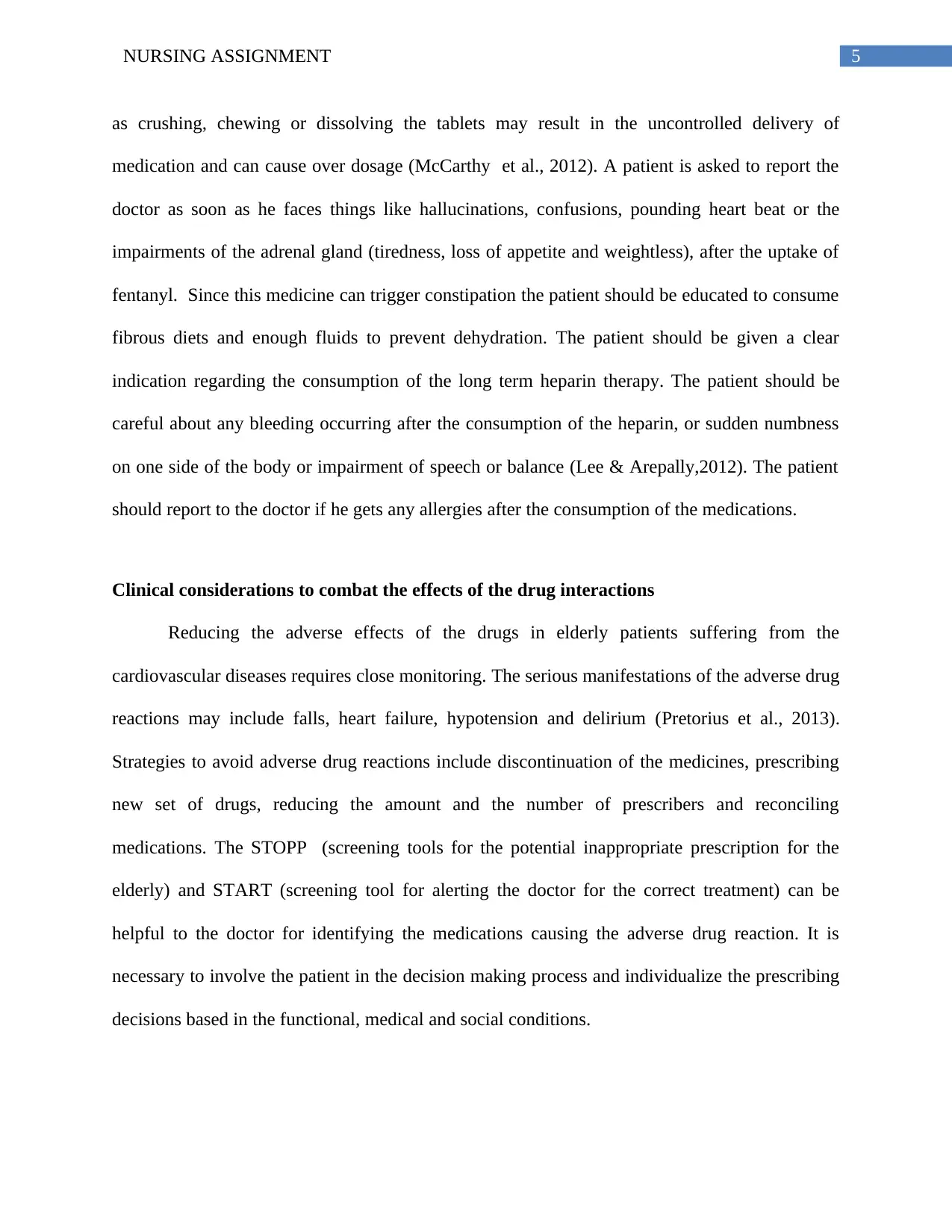
5NURSING ASSIGNMENT
as crushing, chewing or dissolving the tablets may result in the uncontrolled delivery of
medication and can cause over dosage (McCarthy et al., 2012). A patient is asked to report the
doctor as soon as he faces things like hallucinations, confusions, pounding heart beat or the
impairments of the adrenal gland (tiredness, loss of appetite and weightless), after the uptake of
fentanyl. Since this medicine can trigger constipation the patient should be educated to consume
fibrous diets and enough fluids to prevent dehydration. The patient should be given a clear
indication regarding the consumption of the long term heparin therapy. The patient should be
careful about any bleeding occurring after the consumption of the heparin, or sudden numbness
on one side of the body or impairment of speech or balance (Lee & Arepally,2012). The patient
should report to the doctor if he gets any allergies after the consumption of the medications.
Clinical considerations to combat the effects of the drug interactions
Reducing the adverse effects of the drugs in elderly patients suffering from the
cardiovascular diseases requires close monitoring. The serious manifestations of the adverse drug
reactions may include falls, heart failure, hypotension and delirium (Pretorius et al., 2013).
Strategies to avoid adverse drug reactions include discontinuation of the medicines, prescribing
new set of drugs, reducing the amount and the number of prescribers and reconciling
medications. The STOPP (screening tools for the potential inappropriate prescription for the
elderly) and START (screening tool for alerting the doctor for the correct treatment) can be
helpful to the doctor for identifying the medications causing the adverse drug reaction. It is
necessary to involve the patient in the decision making process and individualize the prescribing
decisions based in the functional, medical and social conditions.
as crushing, chewing or dissolving the tablets may result in the uncontrolled delivery of
medication and can cause over dosage (McCarthy et al., 2012). A patient is asked to report the
doctor as soon as he faces things like hallucinations, confusions, pounding heart beat or the
impairments of the adrenal gland (tiredness, loss of appetite and weightless), after the uptake of
fentanyl. Since this medicine can trigger constipation the patient should be educated to consume
fibrous diets and enough fluids to prevent dehydration. The patient should be given a clear
indication regarding the consumption of the long term heparin therapy. The patient should be
careful about any bleeding occurring after the consumption of the heparin, or sudden numbness
on one side of the body or impairment of speech or balance (Lee & Arepally,2012). The patient
should report to the doctor if he gets any allergies after the consumption of the medications.
Clinical considerations to combat the effects of the drug interactions
Reducing the adverse effects of the drugs in elderly patients suffering from the
cardiovascular diseases requires close monitoring. The serious manifestations of the adverse drug
reactions may include falls, heart failure, hypotension and delirium (Pretorius et al., 2013).
Strategies to avoid adverse drug reactions include discontinuation of the medicines, prescribing
new set of drugs, reducing the amount and the number of prescribers and reconciling
medications. The STOPP (screening tools for the potential inappropriate prescription for the
elderly) and START (screening tool for alerting the doctor for the correct treatment) can be
helpful to the doctor for identifying the medications causing the adverse drug reaction. It is
necessary to involve the patient in the decision making process and individualize the prescribing
decisions based in the functional, medical and social conditions.
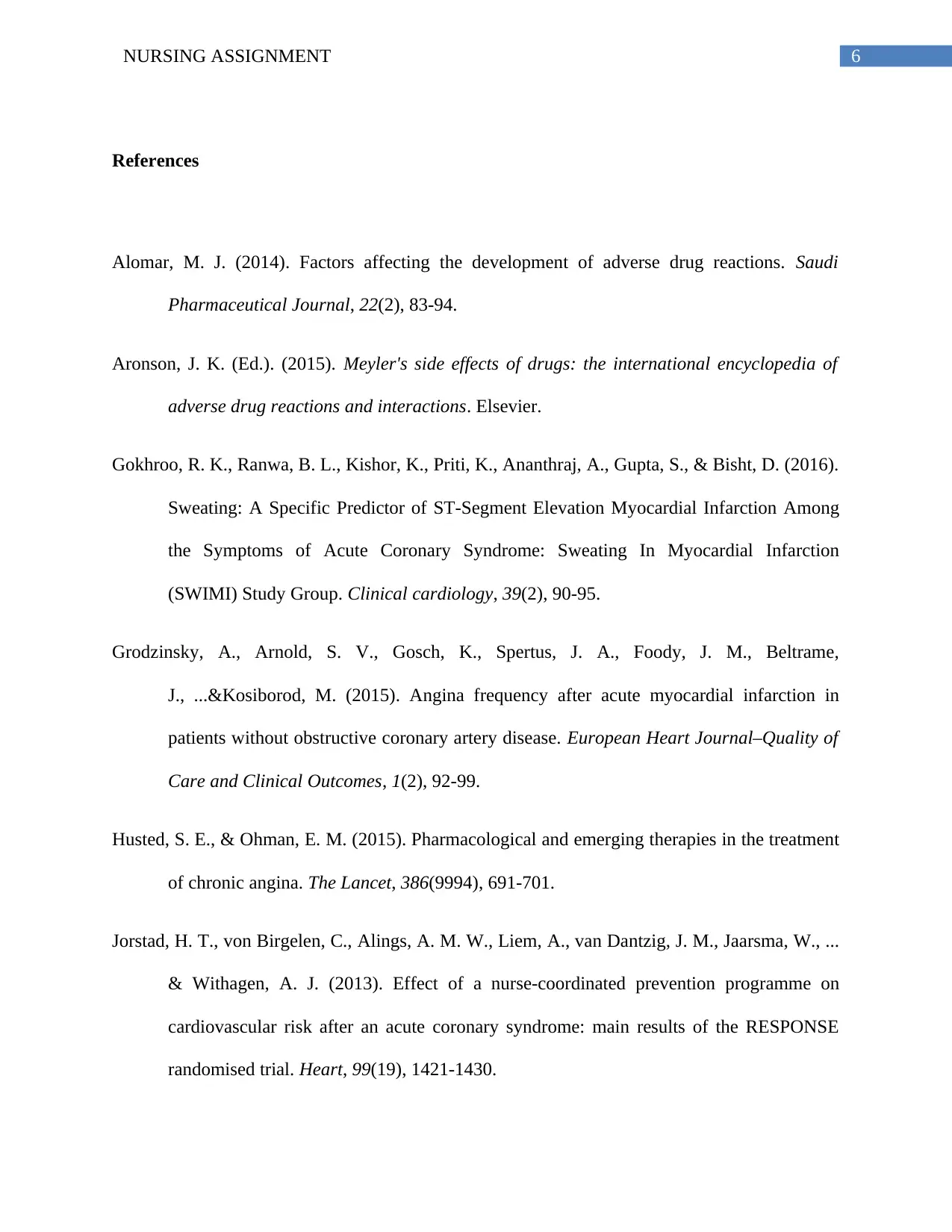
6NURSING ASSIGNMENT
References
Alomar, M. J. (2014). Factors affecting the development of adverse drug reactions. Saudi
Pharmaceutical Journal, 22(2), 83-94.
Aronson, J. K. (Ed.). (2015). Meyler's side effects of drugs: the international encyclopedia of
adverse drug reactions and interactions. Elsevier.
Gokhroo, R. K., Ranwa, B. L., Kishor, K., Priti, K., Ananthraj, A., Gupta, S., & Bisht, D. (2016).
Sweating: A Specific Predictor of ST‐Segment Elevation Myocardial Infarction Among
the Symptoms of Acute Coronary Syndrome: Sweating In Myocardial Infarction
(SWIMI) Study Group. Clinical cardiology, 39(2), 90-95.
Grodzinsky, A., Arnold, S. V., Gosch, K., Spertus, J. A., Foody, J. M., Beltrame,
J., ...&Kosiborod, M. (2015). Angina frequency after acute myocardial infarction in
patients without obstructive coronary artery disease. European Heart Journal–Quality of
Care and Clinical Outcomes, 1(2), 92-99.
Husted, S. E., & Ohman, E. M. (2015). Pharmacological and emerging therapies in the treatment
of chronic angina. The Lancet, 386(9994), 691-701.
Jorstad, H. T., von Birgelen, C., Alings, A. M. W., Liem, A., van Dantzig, J. M., Jaarsma, W., ...
& Withagen, A. J. (2013). Effect of a nurse-coordinated prevention programme on
cardiovascular risk after an acute coronary syndrome: main results of the RESPONSE
randomised trial. Heart, 99(19), 1421-1430.
References
Alomar, M. J. (2014). Factors affecting the development of adverse drug reactions. Saudi
Pharmaceutical Journal, 22(2), 83-94.
Aronson, J. K. (Ed.). (2015). Meyler's side effects of drugs: the international encyclopedia of
adverse drug reactions and interactions. Elsevier.
Gokhroo, R. K., Ranwa, B. L., Kishor, K., Priti, K., Ananthraj, A., Gupta, S., & Bisht, D. (2016).
Sweating: A Specific Predictor of ST‐Segment Elevation Myocardial Infarction Among
the Symptoms of Acute Coronary Syndrome: Sweating In Myocardial Infarction
(SWIMI) Study Group. Clinical cardiology, 39(2), 90-95.
Grodzinsky, A., Arnold, S. V., Gosch, K., Spertus, J. A., Foody, J. M., Beltrame,
J., ...&Kosiborod, M. (2015). Angina frequency after acute myocardial infarction in
patients without obstructive coronary artery disease. European Heart Journal–Quality of
Care and Clinical Outcomes, 1(2), 92-99.
Husted, S. E., & Ohman, E. M. (2015). Pharmacological and emerging therapies in the treatment
of chronic angina. The Lancet, 386(9994), 691-701.
Jorstad, H. T., von Birgelen, C., Alings, A. M. W., Liem, A., van Dantzig, J. M., Jaarsma, W., ...
& Withagen, A. J. (2013). Effect of a nurse-coordinated prevention programme on
cardiovascular risk after an acute coronary syndrome: main results of the RESPONSE
randomised trial. Heart, 99(19), 1421-1430.
Paraphrase This Document
Need a fresh take? Get an instant paraphrase of this document with our AI Paraphraser
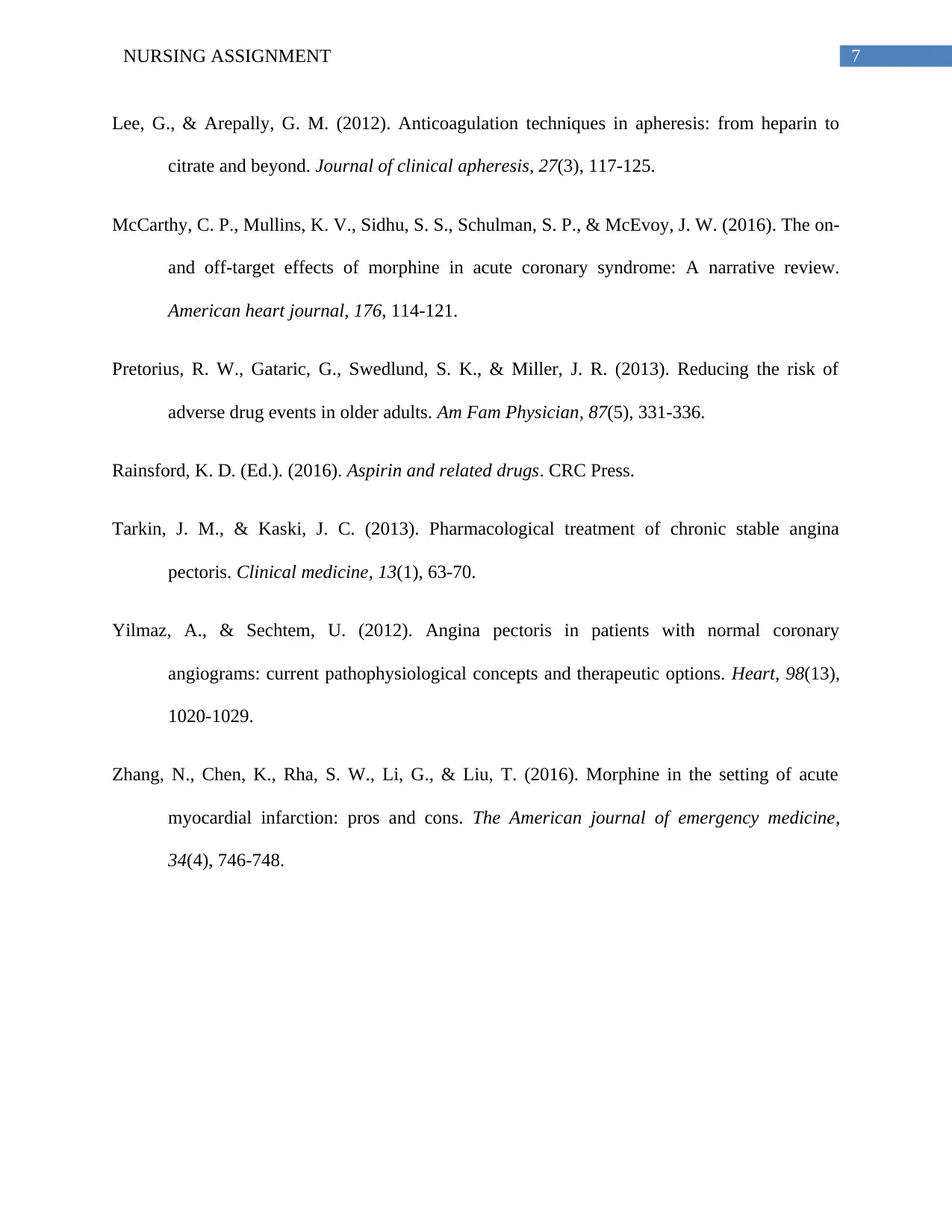
7NURSING ASSIGNMENT
Lee, G., & Arepally, G. M. (2012). Anticoagulation techniques in apheresis: from heparin to
citrate and beyond. Journal of clinical apheresis, 27(3), 117-125.
McCarthy, C. P., Mullins, K. V., Sidhu, S. S., Schulman, S. P., & McEvoy, J. W. (2016). The on-
and off-target effects of morphine in acute coronary syndrome: A narrative review.
American heart journal, 176, 114-121.
Pretorius, R. W., Gataric, G., Swedlund, S. K., & Miller, J. R. (2013). Reducing the risk of
adverse drug events in older adults. Am Fam Physician, 87(5), 331-336.
Rainsford, K. D. (Ed.). (2016). Aspirin and related drugs. CRC Press.
Tarkin, J. M., & Kaski, J. C. (2013). Pharmacological treatment of chronic stable angina
pectoris. Clinical medicine, 13(1), 63-70.
Yilmaz, A., & Sechtem, U. (2012). Angina pectoris in patients with normal coronary
angiograms: current pathophysiological concepts and therapeutic options. Heart, 98(13),
1020-1029.
Zhang, N., Chen, K., Rha, S. W., Li, G., & Liu, T. (2016). Morphine in the setting of acute
myocardial infarction: pros and cons. The American journal of emergency medicine,
34(4), 746-748.
Lee, G., & Arepally, G. M. (2012). Anticoagulation techniques in apheresis: from heparin to
citrate and beyond. Journal of clinical apheresis, 27(3), 117-125.
McCarthy, C. P., Mullins, K. V., Sidhu, S. S., Schulman, S. P., & McEvoy, J. W. (2016). The on-
and off-target effects of morphine in acute coronary syndrome: A narrative review.
American heart journal, 176, 114-121.
Pretorius, R. W., Gataric, G., Swedlund, S. K., & Miller, J. R. (2013). Reducing the risk of
adverse drug events in older adults. Am Fam Physician, 87(5), 331-336.
Rainsford, K. D. (Ed.). (2016). Aspirin and related drugs. CRC Press.
Tarkin, J. M., & Kaski, J. C. (2013). Pharmacological treatment of chronic stable angina
pectoris. Clinical medicine, 13(1), 63-70.
Yilmaz, A., & Sechtem, U. (2012). Angina pectoris in patients with normal coronary
angiograms: current pathophysiological concepts and therapeutic options. Heart, 98(13),
1020-1029.
Zhang, N., Chen, K., Rha, S. W., Li, G., & Liu, T. (2016). Morphine in the setting of acute
myocardial infarction: pros and cons. The American journal of emergency medicine,
34(4), 746-748.
1 out of 8
Related Documents
Your All-in-One AI-Powered Toolkit for Academic Success.
+13062052269
info@desklib.com
Available 24*7 on WhatsApp / Email
![[object Object]](/_next/static/media/star-bottom.7253800d.svg)
Unlock your academic potential
© 2024 | Zucol Services PVT LTD | All rights reserved.





